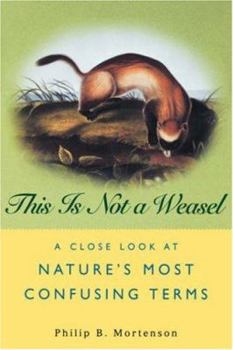This Is Not a Weasel: A Close Look at Nature's Most Confusing Terms
How to tell a bison from a buffalo-not to mention a yam from a sweet potato Here's a book for anyone who's ever wondered about the difference between a crayfish and a crawfish. Or a frog and a toad.... This description may be from another edition of this product.
Format:Paperback
Language:English
ISBN:0471273961
ISBN13:9780471273967
Release Date:October 2003
Publisher:John Wiley & Sons
Length:272 Pages
Weight:1.00 lbs.
Dimensions:0.7" x 6.0" x 9.0"
Customer Reviews
3 ratings
Interesting intersection of linguistics and life sciences
Published by Thriftbooks.com User , 20 years ago
If you're one of those people who keep getting *entomology* and *etymology* confused (happens to me all the time), this might be just the book for you. That's because Philip B. Mortenson has produced a work that should appeal not only to natural historians and biologists, but also word geeks and fans of linguistics. I commend him for bridging these very disparate worlds.Divided up into short and easy-to-read sections, Mortenson covers such confusing topics (and topics that some people may not have known were different in the first place) like redwood versus sequoia, rabbit versus hare, shrimp versus prawn, sweet potato versus yam, and a great many others. I always encourage, and try to acknowledge, precision in language and expression. This wide-ranging and entertaining book is both a fun read and a handy reference to have around. I recommend it to both sides of the traditional divide between the sciences and the humanities.
Author comment
Published by Thriftbooks.com User , 20 years ago
Pictures were initially included, but had to be pulled due to legal issues.
Terrific text...needs pictures!
Published by Thriftbooks.com User , 20 years ago
It has been my experience that most people are not concerned one bit about calling a toad a "frog." If you _do_ care, however, and if you are unsure of many of the confusing common names for animals, plants, and fungi, this book is a gem. It begins with an overview of taxonomy, and discusses how some scientists come up with names of newly discovered species (for instance, he explains why there are recently discovered wasps called _Polemistus chewbacca_ and _P. yoda_), a bit about common names, and the derivations of many scientific names--great for building vocabulary, and scientific knowledge at the same time!Each of seven chapters is divided into smaller oft-confused groups...in chapter 3, "Terrestrial Invertebrates," he explains these groups:Insect * Spider * CrustaceanBee * Wasp * Hornet * AntBug * BeetleCentipede * MillipedeDragonfly * DamselflyGrasshopper * Locust * Cricket * KatydidMite * Chigger * Tick * LouseButterfly * Moth * SkipperCaterpillar * Grub * Larva * Maggot * NymphIn Chapter 7, "Mammals," the author lists all the common names for the cougar (There are 33! How confusing!). And he does not limit his examination of taxonomy to North America, so it can be used as a world-wide reference.If it had pictures, it would be a better book, but these days, most of us have the internet which provides near-instant access to photos of most species.






